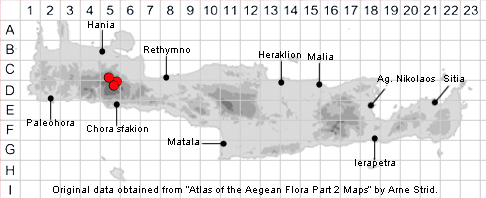SPECIES DESCRIPTION
EUPHORBIA RECHINGERI
Common Names:- None
Homotypic Synonyms:- Euphorbia myrsinites subsp. rechingeri
Meaning:- Euphorbia (L) For Euphorbus, physician to the King of Mauritania.
Rechingeri (L) Possibly for the Austrian botanist Karl Rechinger (1867-
1952).
General description:- Glabrous, glaucous, perennial.
Stems:-
1) Up to 40 cm. decumbent or ascending, numerous, stout, simple, densely leafy,
with 0-3 axillary rays.
Leaves:-
1) Obovate to suborbicular, cuspidate or mucronate, rather thick and fleshy.
2) Ray-leaves, obovate-spathulate to orbicular, mucronate.
3) Raylet-leaves, suborbicular to cordate, mucronate.
Flowers:-
1) Rays, (1-)5-12, dichotomous, variable in length.
2) Glands, with dilated, often wih weakly lobed horns.
Fruit:-
1) Capsule, (4-)5-7 mm, glabrous, smooth or minutely tuberculate.
2) Seeds, (2-)3-4 mm, vermiculate-rugose or rarely smooth, greyish-brown.
Key features:-
1) Glands, horned truncate or emarginate.
2) Horns, of the glands short, often dilated and minutely lobed at the apex.
3) Bracts, between the male flowers absent.
4) Leaves, obovate to suborbicular.
Habitat:- Limestone rocks and scree. 1800-2300m.
Distribution:- Endemic to the Lefka Ori.
Flowering time:- June to early July.
Photos by:- Philippa Dean
Status
Conservation status (for threatened species): Rare (R) according to IUCN 1997
Protection status (for threatened species): Greek Presidential Decree 67/1981
